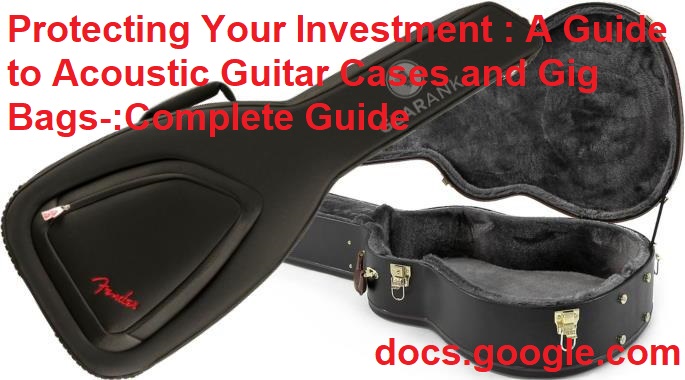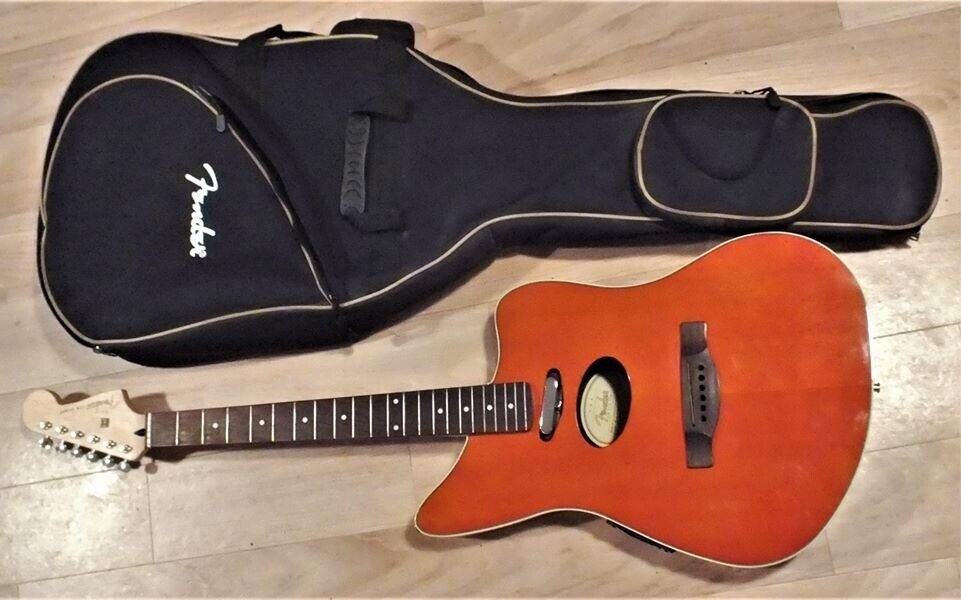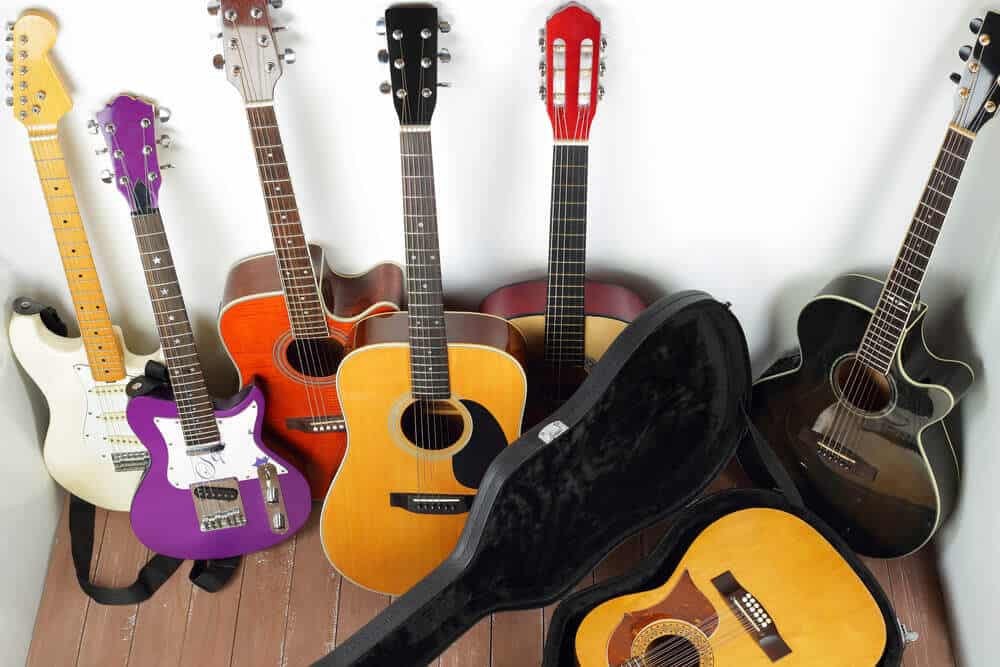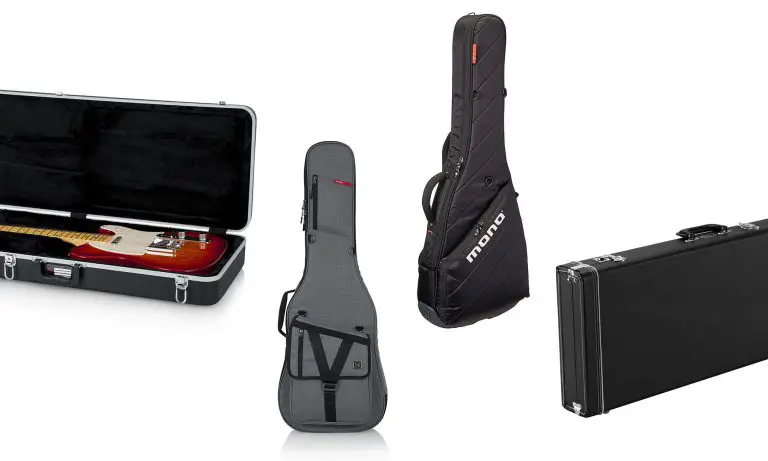Worried about the safety of your beloved acoustic guitar? Protecting your musical investment is essential, and the right acoustic guitar case or gig bag can help you do just that. You need to make sure you have a reliable option for transporting your instrument in style, comfort and safety.
Read on to explore the range of acoustic guitar cases and gig bags available, to discover which one works best for you.
Choosing the best case for your acoustic guitar is not a decision you should take lightly. Protecting your instrument with a quality gig bag or hardshell case will ensure it is preserved and kept in the best condition possible, helping maintain both its sound and aesthetic value. Cases also provide a convenient way to transport your instrument to practice, recording sessions, and live performances.
This guide provides an introduction to acoustic guitar cases and gig bags, comparing their features and benefits so that you can make an informed decision when selecting the right protection for your valued instrument. We’ll discuss size compatibility, interior padding, straps and handles, style and design features of both hardshell cases and gig bags; as well as real-world considerations like cost, portability, weather-proofing capability – all with the sole purpose of helping you choose the solution that’s right for you. Let’s get started!

Features to Look for in an Acoustic Guitar Case
When considering the features of an acoustic guitar case or gig bag, it’s important to focus on protection, convenience, and comfort. Additionally, different brands showcase a variety of features within their designs. For example, you may want to consider a soft-sided case with built-in pockets and straps, while others may opt for a hard-case style design with multiple layers of foam padding.
Protecting the guitar should be your first priority; look for a case that opens fully to provide external support and easy access. The internal finish should be properly padded; additional features like backstraps and handles to make carrying the instrument more comfortable are beneficial too. Consider the weight of the case when making your decision; heavy cases may cause fatigue or back strain.
If opting for a hard-shell style case, look for one that offers greater protection from impacts due to its solid exterior shell. Rigid structures are also preferred when travelling on airplanes as checked baggage as they offer extreme protection from pressure and vibration during transit because most airlines have specific regulations regarding which bag types are allowed in cargo holds. Look for stable hinges or durable closures on these type of cases; latches can also help secure any compartment openings during transportation or storage.
When dealing with weather sensitive components like strings, fretboards and soundboards those looking for greater protection should consider waterproof cases that prevent moisture abroad conditions like rain or humidity damage the instrument’s wood surfaces over time – an oversized design may also provide better control over atmospheric changes inside the case itself – humidity-free interiors will keep guitars safer in fluctuating temperatures and changing weather conditions, not risking prolonged exposure to warmth in one area and coldness in another space inside their covers – rainproof zippers will also come handy when unexpected showers appear while taking instruments out of doors – Always read product reviews before finalizing an investment!
Durability
When considering an acoustic guitar case or gig bag, the most important factor to take into account is durability. An acoustic guitar case should be durable enough to protect your valuable instrument from any potential damage caused by falls, scratches or other hazards. The ideal material for a guitar case should offer excellent shock absorption as well as protection against water and dust to keep your instrument safely guarded at all times.
Gig bags also provide great protection for your acoustic guitar given their durable materials and padded interior. However, they do not provide the same level of protection as a hard-shell case because they are not able to withstand strong impacts that may occur during transportation or when storing the guitar. That said, there are some models available with improved padding as well as reinforced stitching that can help ensure greater protection for your guitar during storage or travel.
Interior Padding

Interior padding on acoustic guitar cases and gig bags provide protection from bumps, small drops, and other types of potentially damaging contact. Many cases and bags come with basic interior padding but some higher-end models can come with more specialized types of padding. There are several different materials that may be used as padding in cases and bags including: foam, felt, wool, artificial fur or synthetic velour. Generally speaking, the more padding a case has the better protection it will offer for your instrument.
Many cases also have an additional layer of rigid plastic which is located along the top edge of the body – this helps to protect your guitar if it is ever dropped or knocked down on its side. Some cases have a rubber lining along their edges as well which can help to prevent scratches or scuffs on your instrument. It’s important to check out all the features when shopping for guitar cases and gig bags in order to make sure that you get one that best fits your needs.
Locking Mechanisms
When selecting a guitar case, it’s important to choose one that offers a secure locking system. Whether you’re regularly taking your instrument on the road or just need peace of mind while out of the house, some form of locking offered on its case is key.
Many cases include built-in locks, usually with a catch and integral padlock design. The advantage is that locks are safeguarded and can’t be removed without the key. Other locking systems use a combination lock and generally invoke greater security protection due to the elimination of keys. There are also cases that utilize a hasp style lock that can be used with an exterior padlock; this provides an added layer of protection when used correctly in situations where cases need to remain secured while away from home.
Storage Space
When picking out a guitar case or gig bag, one thing to keep in mind is whether you need storage space for your accessories and other items. Most cases will have some sort of pocket for picks, straps and strings but the larger cases will have more pockets, perhaps with zippers or Velcro closures, for all your needs.
If you’re wanting something really convenient on the go, consider one of the many hybrid models that offer additional pockets in the form of shoulder or backpack straps. This design is great for those who need to move frequently with their instrument. Gig bags may be easier to transport due to their lighter weight but bear in mind that they won’t offer as much protection as a full-on hardshell case.
Think about how important it is for you to keep everything organized when deciding which type of storage solution is right for you.
Handle and Strap Quality

The ease of transport is also an important factor when you are selecting a case or gig bag for your guitar. Handles and straps should be comfortable, provide adequate grip, and be securely attached. Cases with open handles avoid bulkiness and seem to be the trend (they make picking up the bag easier).
Gig bags commonly have built-in back straps similar to those found on hiking backpacks. Make sure they are securely attached to the bag’s body and constructed with comfortable material that evenly distributes weight – such as padded neoprene straps. Additionally look for reinforce panels that add stability and decrease fatigue.
Lastly if you’re often carrying more than one bulky item, consider a rolling gig bag!
Water Resistance
When it comes to maintaining and protecting your investment, water resistance is a key factor. A guitar case or gig bag with water repellent fabrics or materials is essential for keeping your instrument safe from unwanted moisture, particularly in varying temperature and/or high moisture environments.
Look for a case rated to resist weather conditions like rain and snow. Additionally, some cases come with waterproof liners that fit snugly into the interior of the case for an added layer of protection. Many waterproof liners use PEVA material that is usually enhanced with an air-tight composite to keep out moisture as well as dust.
The best waterproof cases also include air vents to reduce condensation buildup and silicon gaskets to create a tight seal when you close the lid or door of the case.
Choosing the Right Case or Gig Bag for Your Acoustic Guitar

When it comes to choosing the right case or gig bag for your acoustic guitar, it is important to consider several factors.
First, consider the level of protection needed. A hardshell case will provide better protection while a gig bag will be more lightweight and convenient to transport. It is also important to consider other convenience features such as additional pockets for carrying accessories or straps for carrying over the shoulder.
You should also think about size and compartments; larger cases can hold both acoustic and electric guitars, but smaller cases are ideal for travel.
Finally, assess price point and quality; some may prefer reliable cases from manufacturers that offer lifetime warranties whereas other may be looking for more affordable options that still offer basic protection to their instrument.
Factors to Consider
When selecting a case or a gig bag, there are several factors you should keep in mind.
Durability: You want to choose an option that will protect your instrument as thoroughly as possible. Not only do you want to consider the construction materials, such as wood and foam padding, but also ensure that the zippers (if applicable) and any clips or straps close securely.
Weight: Depending on how often you’ll be transporting your guitar, it’s important to select something that won’t be too heavy. Heavier cases may offer greater protection but can get tiresome if they need to be lugged regularly. With gig bags, weight is a non-issue since they tend to be lightweight and made of fabrics that offer extra padding.
Price: As with many items, acoustic guitar cases and gig bags come in virtually every price range and style imaginable. Consider what type of use or abuse your instrument could expect on the road before opting for a certain model.
Purpose
The purpose of purchasing a case or gig bag for your acoustic guitar is twofold: to ensure the protection of one of your most treasured investments and to enable you to free up more time during gigs and rehearsal.
Cases provide superior protection and are typically bulkier, whereas gig bags are lighter and often easier to transport. Depending on the level of protection you need, choosing the right case or gig bag can make a big difference in how well your instrument is preserved for years.
This guide will help you determine which type of case or bag is best for your needs so that you can maximize protection and convenience.
Frequency of Use
When deciding between a hardshell case and a gig bag, one of the most significant factors to consider is how often you will be using it. If you plan on taking your instrument to jams or concerts regularly, or if you’re frequently transporting it in a car or plane, a hardshell case is probably the way to go.
Hardshell cases have been designed from the ground up with rigorous use in mind. Not only will they keep your instrument safer from potential accidents and inclement weather, their thick molded shells also offer the best protection against knocks and bumps during transit. While all but the sturdiest of gig bags will wear out quickly if subjected to frequent transportation, all high-end hardshell cases come with limited lifetime warranties that cover hardware failure and imperfect construction.
However, if you’re mainly taking your guitar around town for lessons or jam sessions with friends who live nearby, a gig bag may suit your needs better. As long as they are constructed out of durable materials and feature good padding (such as 8mm polyethylene foam), they can do an impressive job of protecting your instrument while still maintaining easy portability. Most gig bags also feature additional space for carrying small accessories like tuners and extra strings along with straps that make transporting your guitar by bike more viable than ever before!
Transportation
Transporting your guitar can be challenging, especially if you’re on the move or you don’t have a dedicated vehicle for your instrument. When it comes to protecting your guitar, there are two main options – hard cases and gig bags.
Hard Cases: Hard cases are designed to protect your instrument from damage from drops, bumps, and moisture. They’re usually made of wood or plastic and constructed with foam cushioning inside to provide the most protection possible. Hard cases also great because they have locking systems that make it much harder for someone to steal your guitar.
Gig Bags: Gig bags are lightweight and usually made of nylon with padding on both the outside and the inside of the bag. While they do provide some protection, they won’t be as protective as a hard case so they’re better used for short trips. They also tend to not weigh as much as cases so they’re a great option if you need something lightweight but still want some level of protection.
Conclusion
In conclusion, cases and gig bags can help you protect your investment in an acoustic guitar for years to come. From hardshell cases that provide the maximum level of protection, to padded gig bags that provide just enough protection for occasional use, there’s a case or gig bag that’s perfect for protecting your instrument.
No matter which type of case or bag you choose, you will be taking a proactive step to ensure your acoustic guitar lasts as long as possible.
FAQs
Will a gig bag protect my guitar?
A gig bag can provide some protection for your guitar, but it may not be as effective as a hard case in protecting your instrument from impacts or falls.
Is it bad to leave guitar in gig bag?
Leaving your guitar in a gig bag for an extended period may not be the best idea as it can trap moisture and humidity, potentially causing damage to your guitar.
What is the difference between a gig bag and a guitar case?
A gig bag is made of soft materials such as nylon or leather and offers basic protection from scratches, whereas a guitar case is made of harder materials such as plastic or wood and provides more advanced protection from impacts or falls.
How do I protect my guitar case?
To protect your guitar case, you can use a case cover, avoid exposing it to extreme temperatures or humidity, and handle it with care.
What is better, a guitar case, or a bag?
A guitar case offers better protection than a gig bag, especially when it comes to impacts or falls. However, a gig bag is more portable and easier to carry around.
Do gig bags protect guitars from humidity?
Gig bags may offer some protection from humidity, but they are not entirely effective in preventing damage caused by high levels of humidity.
What makes a guitar gig-worthy?
A guitar is considered gig-worthy if it has good intonation, plays well, and stays in tune. It should also be durable and able to withstand the rigors of gigging.
How long do guitar strings last in a bag?
Guitar strings can last for several months to a year in a bag if they are stored in a dry and cool place and are not exposed to moisture or humidity.
Is it OK to leave a guitar out of the case?
Leaving your guitar out of the case is generally safe if it is stored in a dry and cool place, away from direct sunlight or humidity. However, it is always best to store your guitar in a case to protect it from potential damage.
Should you keep silica gel in a guitar case?
Yes, silica gel can help absorb moisture and prevent damage caused by humidity in your guitar case. It is recommended to keep silica gel packets inside your guitar case, especially if you live in an area with high humidity levels.
See Also :
- Best over sink dish rack 2023
- Best wheelchair accessible bathroom sink 2023
- Best laundry room sink 2023
- Best vessel sink 2023
- Best bar sink faucet 2023

